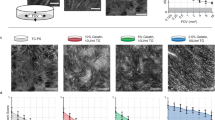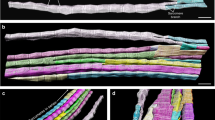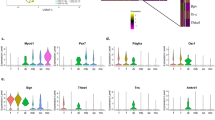Abstract
COLLAGEN is the major structural protein in the supporting and connective tissues. In addition to its mechanical properties it has been considered to be involved in developmental processes1–3. Previous studies on muscle development have concentrated on the contractile components but more recently there has been a realisation of the significance of connective tissue in this process. For example, in vitro studies have demonstrated the importance of a collagen substrate in promoting myoblast differentiation4, and more recently it was shown that all types of collagen were equally effective5: Mayne et al.6 demonstrated that clones of chick muscle cells were capable of synthesising type I collagen. Ketley et al.5 confirmed the synthesis of type I collagen and also reported that the collagen in intact chick muscle was solely of this type. On the other hand, Duance et al.7 and Bailey and Sims8 investigated the distribution of the genetically different collagen types within bovine muscle connective tissue and showed by biochemical and immunofluorescent techniques a specific distribution of the isomorphic forms of collagen in this tissue. Here we report our studies on the development of chick skeletal muscle which were designed to investigate some pertinent points: (1) the distribution of collagen types in chick muscle; (2) the role of collagen in the development of muscle as a functional tissue; (3) the cellular derivation of these different collagens. Chick muscle was chosen, first, because much is known about its development and differentiation in vitro, and second, because it is possible to manipulate its early development in the embryo in vivo9,10. We have isolated three isomorphic forms of collagen from chick muscle, and using immunofluorescent techniques demonstrate a specific distribution of these collagen types within this tissue. Finally we have used in vitro muscle cell culture to examine how this distribution is achieved by temporal transitions in synthesis. These results suggest that collagen has a subtle role in the development of muscle.
This is a preview of subscription content, access via your institution
Access options
Subscribe to this journal
Receive 51 print issues and online access
$199.00 per year
only $3.90 per issue
Buy this article
- Purchase on Springer Link
- Instant access to full article PDF
Prices may be subject to local taxes which are calculated during checkout
Similar content being viewed by others
References
Weiss, P. in Biological Organisation (ed. Waddington, C. H.) (Pergamon, Oxford, 1959).
Grobstein, C. in Aspects of Synthesis in Order and Growth (ed. Rudnick, D.) (Princeton University Press, 1954).
Fitton-Jackson, S. in Treatise on Collagen Vol. 28 (ed. Gould, B. S.) (Academic, New York, 1968).
Hauschka, S. D. & Konigsberg, I. R. Proc. natn. Acad. Sci. U.S.A. 55, 119–126 (1966).
Ketley, J. N., Orkin, R. W. & Martin, G. R. Expl Cell Res. 99, 261–268 (1976).
Mayne, R. & Strahs, K. R. J. Cell Biol. 63, 212a (1974).
Duance, V. C., Restall, D. J., Beard, H., Bourne, F. J. & Bailey, A. J. FEBS Lett. 79, 248–252 (1977).
Bailey, A. J. & Sims, T. J. J. Sci. Fd Agric. 28, 565–570 (1977).
Shellswell, G. B. & Wolpert, L. in Vertebrate Limb and Somite Morphogenesis (eds Ede, D., Hinchcliffe, R. & Balls, M.) (Cambridge University Press, 1977).
Shellswell, G. B. thesis, Univ. London (1977).
Burgeson, R. E., El Adli, F. A., Kartila, I. I. & Hollister, D. A. Proc. natn. Acad. Sci. U.S.A. 73, 2579–2583 (1976).
Bentz, H., Bächinger, H. P., Glanville, R. & Kuhn, K. Eur. J. Biochem. 92, 563–568 (1978).
Rhodes, K. R. & Miller, E. J. Biochemistry 17, 3443–3448 (1978).
Lipton, B. H. Devl Biol. 61, 153–165 (1977).
Wolpert, L. Sci. Am. 239, 124–137 (1978).
Wolpert, L. Curr. Top. dev. Biol. 6, 183–224 (1971).
Yaffe, D. Curr. Top. dev. Biol. 4, 37–75 (1969).
Herbert, W. J. in Handbook of Experimental Immunology (ed. Weir, D. M.) (Blackwell, Oxford, 1967).
Sykes, B., Puddle, B., Francis, M. & Smith, R. Biochem. biophys. Res. Commun. 72, 1472–1480 (1976).
Author information
Authors and Affiliations
Rights and permissions
About this article
Cite this article
BAILEY, A., SHELLSWELL, G. & DUANCE, V. Identification and change of collagen types in differentiating myoblasts and developing chick muscle. Nature 278, 67–69 (1979). https://doi.org/10.1038/278067a0
Received:
Accepted:
Issue Date:
DOI: https://doi.org/10.1038/278067a0
This article is cited by
-
Intrinsic skeletal muscle alterations in chronic heart failure patients: a disease-specific myopathy or a result of deconditioning?
Heart Failure Reviews (2012)
-
Purification and partial characterization of a type V like collagen from the muscle of marine prawn,Penaeus indicus
Journal of Biosciences (1997)
-
Regenerative capacity of mdx mouse muscles after repeated applications of myo-necrotic bupivacaine
Acta Neuropathologica (1995)
-
Embryonic chicken gizzard: immunolocalization of collagen and smooth muscle myosin
Cell & Tissue Research (1992)
Comments
By submitting a comment you agree to abide by our Terms and Community Guidelines. If you find something abusive or that does not comply with our terms or guidelines please flag it as inappropriate.



